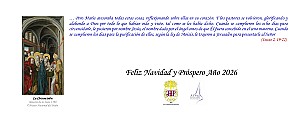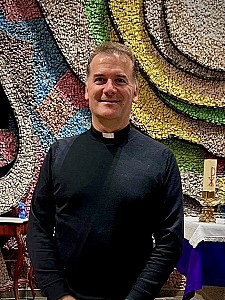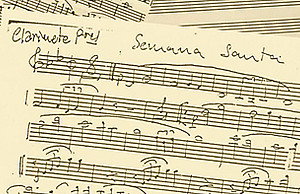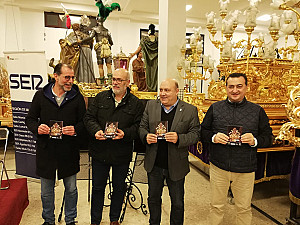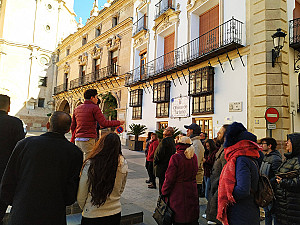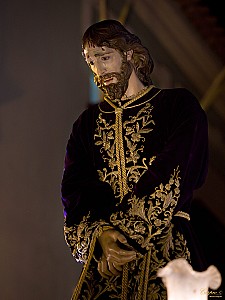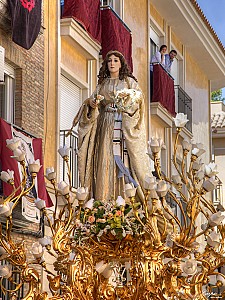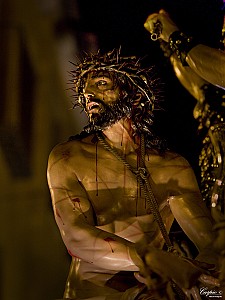El origen de la actual Cofradía de Jesús -Nazareno- está vinculado a dos de las primeras Cofradías de las que se tiene noticia en nuestra ciudad, la de la Sangre de Cristo y la del Dulce y Santísimo Nombre de Jesús, cuya antigüedad puede remontarse a los primeros decenios del siglo XV. Con esa marca de antigüedad aparecen mencionadas en la Descripción y Relación de la Villa de Cieza que, por mandato de Felipe II, redacta el Bachiller Alonso Marín y Mena en el año 1579: "A veinticinco días del mes de Marzo, año del nacimiento de nuestro redemptor Jesucristo, de mil y quinientos y setenta y nueve, el bachiller Alonso Marín y Mena, de edad de quarenta años, y Joan García, el viejo, de edad de ochenta, y Martín Ruiz de Soler, el viejo, de edad de setenta y uno, vecinos y naturales desta dicha villa... A los cuarenta capítulos dixeron: ay tres Cofradías, una del dicho Apóstol San Bartolomé, otra de la Sangre de Cristo, y otra del Dulce y Santísimo Nombre de Jhesús".
Por una parte y tal como revela el periodista local de finales del s. XIX y principios del XX Ramón María Capdevila, la Cofradía de la Sangre de Cristo hizo en 1655 "una Imagen con la Cruz a cuestas para las procesiones de Semana Santa" y recibió licencia del Sr. Obispo para construirle un altar en la parroquial.
Pero en 1692, la Cofradía de Jesús de Nazareno (y con ella la de Nuestra Señora de la Soledad) solicita su erección estableciendo constituciones propias para "poder solemniçar la semana santa de cada una de las procesiones que seaçen con estas santas Ynsinias los dias Jueves y Viernes" (incluso pasará a tutelar el Paso El Santo Sepulcro cuando la Cofradía de la Sangre desaparezca). Ambas Cofradías, Nazareno y Soledad, quedarán, por otra parte, íntimamente ligadas entre sí desde entonces en sus cultos; de hecho durante el siglo XIX y principios del XX organizan conjuntamente el Novenario de Dolores, entonces Novenario de Jesús y Dolores, costeando a partes iguales el altar para el mismo iniciado a finales del siglo XIX y finalizado en 1908 tras su dorado por Pedro Valch.
Con ésa y otras advocaciones aparecerá nombrada la Cofradía a partir de ese momento: Cofradía de Nuestro Padre Jesús, Cofradía de Nuestro Señor Padre Jesús o Cofradía de Nuestro Padre Jesús Nazareno, y popularmente Cofradía de Jesús; así, por ejemplo, en 1722 el testamento otorgado por D. Luis Daroca Marín: "y asimismo me asista y acompañe mi cuerpo la Cofradía de Nuestro Padre Jesús en conformidad de su obligación y con la consideración de haber sido su Hermano Mayor".
Por otra parte cuando la Cofradía de Jesús se constituyó es muy probable que se hiciera cargo de los fines de la Cofradía del Dulce y Santísimo Nombre de Jesús; de hecho todavía a principios del siglo XX la Cofradía de Jesús Nazareno organiza y costea la Función del Dulce Nombre de Jesús, de cuya celebración hay constancia ya en 1671 y que aparece en la relación de un Acta Capitular de 1693: "Esta villa tiene por costumbre y devoción asistir a diferentes fiestas y procesiones generales por decretos y botos para que en todo tiempo conste las que son acordaron lo fuesen la del Dulce Nombre de Jesús,…".
La Cofradía de Jesús -Nazareno- pasaría por tanto por ser, de entre todas las existentes en la actualidad y que han mantenido su continuidad en el tiempo, la Cofradía pasionaria más antigua de Cieza; así parece corroborarlo, por otro lado, una carta fechada el 12 de noviembre de 1858 y conservada en la Parroquia de Nuestra Señora de la Asunción de Cieza en la cual el Obispo de Cartagena, Don Mariano Barrios Fernández, dicta unas normas para su cumplimiento en los Desfiles Procesionales: "...se coloque cada Cofradía con su respectiva efigie o Paso en el lugar y sitio que le corresponde, no con sujeción de su mayor o menor antigüedad, sino al que le sea natural guardando el orden histórico que cada Paso representa en la Pasión de Nuestro Señor Jesucristo... Sin embargo y como una señal evidente de lo atendible al derecho de antigüedad acordamos que el Hermano Mayor que por tiempo fuere de la Cofradía de Nuestro Padre Jesús, ocupe en las indicadas Procesiones el lugar que corresponde a la antigüedad de la Cofradía a quien representa con lo que guarda a salvo todo derecho" (curiosamente una fotografía del Paso de Santa María Magdalena abriendo el cortejo Procesional en la mañana de Viernes Santo a finales del siglo XIX o principios del XX nos muestra en primer término, encabezando la Procesión, a D. Antonio Aguado Moxó, Hermano Mayor de la Cofradía de Jesús).
La Cofradía tenía un marcado carácter penitencial: era costumbre que los cofrades asistieran a la Procesión con su túnica, cruz y soga, con los pies descalzos, de forma anónima, sin hablar unos con otros, y portando hachones de cera (cierta reminiscencia de ese carácter penitencial sigue vigente hoy: su Tercio de nazarenos desfila con cruces de madera en la Procesión del Penitente Viernes Santo en la mañana y hasta hace pocos años no era raro que muchos de ellos lo hicieran descalzos). El hábito de pedir limosna en el transcurso de la Procesión y en las puertas de las iglesias durante la visita a los Monumentos proporcionó a la Cofradía sustanciosos ingresos a los que hay que sumar los muchos otros derivados de las mandas testamentarias. Parte de los mismos se destinaban a sufragar los gastos derivados de los entierros de los Cofrades; así D. Mariano Ruiz-Funes en su obra de 1916 Derecho consuetudinario y economía popular de la provincia de Murcia contaba que "en Cieza hay la costumbre de anunciar los entierros de los hermanos de la Cofradía de Nuestro Padre Jesús. Un chico va por la calle, silencioso, tocando una campanilla. La gente que conoce el acto, le pregunta el nombre del difunto, y él lo dice".
Entre finales del siglo XVIII y mediados del XIX el auge de la Cofradía es tal que además de su titular adquiere o agrupa en torno a ella Pasos como El Señor de la Columna (posteriormente completado con las Imágenes de dos Sayones), La Oración del Huerto, Jesús Resucitado y, como antes se ha dicho, El Santo Sepulcro (cuyo palio renueva la Cofradía en 1851), de los que sufraga sus sucesivas reparaciones y restauraciones según refleja el Libro de Cuentas de la Cofradía (1850-1963), y su desfile lo encabezan un guión que es renovado varias veces (1902 y 1923) antes de su desaparición y una gran bocina sobre ruedas, integrando también el cortejo un grupo de clarines. También es probable que en las mismas fechas se constituyera bajo sus auspicios, si es que no lo hizo como filial, la Hermandad de la Convocatoria de Jesús, los populares 'Armaos' (hoy Tercio Romano del Santo Sepulcro), cuya actividad en Semana Santa se centra esencialmente en la representación del Prendimiento, Acto que esta misma organiza y costea; y es posible, incluso, que el Paso de Jesús Nazareno -Prendido- dejara de participar en la misma tras la implantación del Prendimiento, que se celebraba con dicho Paso un día antes, para volver a hacerlo definitivamente tras la Guerra Civil; así parece desprenderse de algunas crónicas de la Semanas Santas de finales del siglo XIX en la que este Paso no consta en la relación de los que desfilaban en la Procesión General.
En la segunda mitad del siglo XIX, siendo Hermano Mayor D. Antonio Aguado Marín, al que luego sucederá en el cargo su hijo D. Antonio Aguado Moxó (que como tal consta en el Acta de Constitución de la Junta de Procesiones en 1915) la Cofradía de Jesús Nazareno cuenta con un elevado número de Cofrades que pagan tarja, lo que le permite contratar Bandas de música de otras localidades para las Procesiones (es el caso de la Banda de Abarán en 1855) e incluso dispone de su propia oficina. Pero a pesar de su importancia y protagonismo, la Guerra Civil provocará su desarticulación y al término de la misma surgirán, como filiales suyas en los primeros momentos, pero completamente independientes en breve tiempo las Cofradías de la Oración del Huerto y de Jesús Resucitado.
Tras su reorganización en los primeros años en la década de los cuarenta del pasado siglo XX, la Cofradía sustituyó por las actuales las tradicionales túnicas de cola con adornos de pasamanería y cinchos de esparto.
De las esculturas que de la Imagen de Jesús Nazareno se hayan podido suceder en el tiempo conocemos dos. Los testimonios gráficos de la primera, destruida en la quema de Santos del año 1936, hablan de una Imagen de innegable filiación a la escuela andaluza, cuya autoría varios estudiosos han pretendido atribuir a la Escuela del imaginero sevillano Juan Martínez Montañés (1568-1648), concretamente a Juan Sánchez Cordobés, según los estudios del Profesor Sánchez Moreno. La Imagen era una pieza escultórica de gran mérito y su singularidad resaltó sobre el resto, llamando la atención tanto de los vecinos de la localidad como de aquellos que se acercaban a ella, caso de D. Manuel González Simancas, autor del Catálogo Monumental de España, que visitó Cieza en 1893, o de quien bajo las iniciales E.B. rubrica un artículo periodístico en el que afirma: "La efigie de Jesús es la mejor escultura de estas Proceisones". Muy importante debió ser, además, la veneración que le profesó el pueblo por cuanto en el siglo XIX fue muy frecuente la impresión y venta de sus estampas, y su participación en rogativas.
La segunda, la actual, fue encargada por D. Mariano Martínez Montiel al valenciano Ignacio Pinazo, que la acabó para la Semana Santa de 1942. Es una Imagen vestida con una rica túnica de terciopelo morado que perteneció a la Imagen anterior y que, desaparecida durante la guerra civil, fue recuperada casualmente años después en El Palmar (Murcia). En la Procesión del Penitente, Viernes Santo en la mañana, la Imagen desfila coronada de espinas (con una corona labrada en plata el siglo pasado) y con una cruz al hombro (restaurada en 2005 por Bonifacio Pérez Ballesteros), que se adapta a sus brazos articulados y a unas manos realizadas en 1946 por el imaginero ciezano Manuel Juan Carrillo Marco, y que sustituye a la cruz con que desfilaba desde el siglo pasado, singular por tener un brazo más corto que otro. La Imagen siempre se conservó en la Basílica de Nuestra Señora de la Asunción, ubicándose su capilla en el lugar que hoy ocupa entre los años 1680 y 1710, en el transcurso de las obras de remodelación y ampliación de aquella.
El trono en el que procesiona la Imagen de Jesús Nazareno, sustituto de otro realizado en 1861 por Antonio Torres y dorado tres años después, constituye una obra de arte en madera tallada y dorada. Debajo del mismo, en su parte interior, figura la siguiente inscripción: "Se costeó este Trono para la Imagen de Nuestro Padre Jesús de esta parroquia por las señoras Doña Piedad y Doña Amalia Angostos Peña, camareras de dicha Imagen. Fue construido en Murcia por el maestro tallista D. Pedro García Migal año de 1899 y se doró en Cieza por el vecino de la misma D. Ignacio Amoraga Latorre natural de Murcia en el año 1900". El trono fue restaurado y vuelto a dorar en el año 1999 por el artista ciezano Bonifacio Pérez Ballesteros, quien también talló para el mismo un juego de puntas de vara en el año 2004.
La Cofradía posee también el Paso de Santa María Salomé realizado en 1953 por el escultor Octavio Vicent y al que en un principio intentó convertir en titular de una Hermandad filial del mismo nombre, sin que esta iniciativa llegara a concretarse. Se trata de una Imagen de vestir que desfila el Viernes Santo en la noche en la Procesión del Santo Entierro, llevando en sus manos la corona de espinas y los clavos de Cristo, y en la Procesión del Resucitado, Domingo de Pascua, sin los atributos de la Pasión. El trono sobre el que procesiona es obra de Manuel Juan Carrillo Marco al que se le encargó en 1954, quedando completamente terminado y desfilando por primera vez dos años después; al igual que el del Paso titular, fue restaurado y dorado nuevamente el año 2001 en los talleres de Bonifacio Pérez Ballesteros, quien talló en madera y doró un juego de puntas de vara para el mismo en 2007, y restauró también la Imagen de Santa María Salomé un año después.
En 1996 la Cofradía, bajo el mandato de D. Francisco López Yuste, adquirió un estandarte de terciopelo morado bordado en oro y pedrerías por las Religiosas Justinianas Madres de Dios de Murcia y dos faroles para el Tercio de nazarenos labrados en plata en los Talleres de los Hermanos Ramos de Sevilla; y en 1998 Mari Carmen Lozar Vázquez confeccionó, en terciopelo morado bordado en oro, unas Galas para el trono del Paso titular.
Bajo la Presidencia de su actual, D. Antonio Camacho Vázquez, la Cofradía añadió a su vestuario en 2006 un medallón y tres años después, en 2009, incorporó a la Procesión General, y en sustitución de su Titular, el Paso La Coronación de Espinas, un grupo escultórico formado por la Imagen del Señor -tallada en madera- y la de un soldado romano –de vestir- por el insigne escultor cordobés Francisco Romero Zafra que desfila sobre un trono tallado en madera con detalles en plata, cuya realización comenzó ese mismo año en los talleres cordobeses de los Hermanos Higuera González. Asimismo Hermanas de la Cofradía confeccionaron en 2010 un vestido de terciopelo y un manto brocado para la Imagen de Santa María Salomé. Y ya recientemente, en el año 2023, en los Talleres Virgen de los Reyes de Murcia, José Rubio Pastor confeccionó unas nuevas galas para la Cofradía.
Fotografías de Manuel Carpio.
© Junta de Hermandades Pasionarias de Cieza
